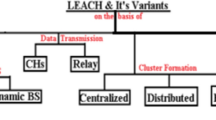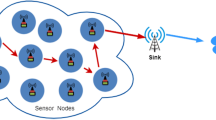Abstract
Wireless sensor network (WSN) has gained an enormous attention of researchers with its dynamic applications. Energy is considered as a scarce and the most vital resource in WSNs. In clustering-based approach, there is huge energy consumption while communicating data from cluster to base station (BS) and from sensor nodes to cluster head within a cluster. The repetitive use of same nodes and paths can result in network hole problem and service unavailability. There are number of research areas which have addressed the issues of energy efficiency and service availability. Load balancing is considered as one of the key techniques which are used to balance the trade-off between energy efficiency and service availability. In this research work, a novel real-time energy efficient load balancing technique for two-tier communication is proposed in which, initially in Tier 1, the energy consumption is reduced for communication between cluster to BS by applying space-time block coding over M-ary quadrature amplitude modulation and binary phase-shift keying modulations. In Tier 2, within a cluster, the energy consumption of communication among sensor nodes and CHs is reduced by utilizing the concepts of feedback control system, in which there is no need of the knowledge of static traffic demands. The performance of the proposed technique has been compared with the existing techniques in terms of energy utilization variation with varying order of transmit diversity and varying cluster BS distances, optimization of constellation sizes, energy utilization variation with cluster–BS distances for varying maximum link utilization and data rates along with varying traffic distribution and topology.














Similar content being viewed by others
References
Akyildiz IF, Su W, Sankarasubramaniam Y, Cayirci E (2002) Wireless sensor networks: a survey. Comput Netw 38(4):393–422
Prabhu SRB, Sophia S (2011) A survey of adaptive distributed clustering algorithms for wireless sensor networks. Int J Comput Sci Eng Surv 2(4):165–176
Kacimia R, Dhaoub R, Beylotb AL (2013) Load balancing techniques for lifetime maximizing in wireless sensor networks. Ad Hoc Netw 11(8):2172–2186
Sendonaris A, Erkip E, Aazhang B (2003) User cooperation diversity. Part I. System description. IEEE Trans Commun 51(11):1927–1938
Sendonaris A, Erkip E, Aazhang B (2003) User cooperation diversity. Part II. Implementation aspects and performance analysis. IEEE Trans Commun 51(11):1939–1948
Ng F, Li X (2005) Cooperative STBC-OFDM transmissions with imperfect synchronization in time and frequency. In: Conference Record of the Thirty-Ninth Asilomar Conference on Signals, Systems and Computers, Pacific Grove, Nov 2005, pp 524–528
Li X (2003) Energy efficient wireless sensor networks with transmission diversity. Electron Lett 39(24):1753–1755
Laneman JN, Wornell GW (2003) Distributed space-time coded protocols for exploiting cooperative diversity in wireless networks. IEEE Trans Inf Theory 49(10):2415–2425
Astrom KJ, Murray RM (2010) Feedback systems: an introduction for scientists and engineers. Princeton University Press, Princeton
Jacobson V, Smetters DK, Thornton JD, Plass MF, Briggs NH, Braynard RL (2009) Networking named content. In: Proceedings of the 5th ACM International Conference on Emerging Networking Experiments and Technologies 2009, Roma, Dec 2009, pp 1–12
Meisel M, Pappas V, Zhang L (2010) Ad hoc networking via named data. In: Proceedings of the 5th ACM international workshop on mobility in the evolving internet architecture (MobiArch ’10). Chicago, Sept 2010, pp 3–8
Internet Protocol. http://datatracker.ietf.org/doc/rfc791/. Accessed on 20 Sept 2016
Transmission Control Protocol. http://datatracker.ietf.org/doc/rfc793/. Accessed on 22 Sept 2016
Network Simulation 2 (NS2), Univ. USC/ISI, Xerox PARC, LBNL and UCB, US. Accessed on 3 Aug 2017
Wang J, Yang X, Ma T, Wu M, Kim J-U (2012) An energy efficient competitive clustering algorithm for wireless sensor networks using mobile sink. Int J Grid Distrib Comput 5(4):79–92
“GT-ITM,” CC, Georgia Institute of Technology, US Accessed on 16 Aug 2017
“Inet-3.0,” CCES, University of Michigan, US accessed on 16 Aug 2017
Kim HY (2016) An energy-efficient load balancing scheme to extend lifetime in wireless sensor networks. Clust Comput 19(1):279–283
Poornima P, Rajesh R (2016) Mobility control based dual data transmission for load balancing in WSN. Middle-East J Sci Res 24:193–200
Gherbi C, Aliouat Z, Benmohammed M (2016) An adaptive clustering approach to dynamic load balancing and energy efficiency in wireless sensor networks. Energy 114:647–662
Zhao M, Yang Y, Wang C (2015) Mobile data gathering with load balanced clustering and dual data uploading in wireless sensor networks. IEEE Trans Mobile Comput 14(4):770–785
Cui J, Goldsmith AJ, Bahai A (2004) Energy-efficiency of MIMO and cooperative MIMO techniques in sensor networks. IEEE J Sel Areas Commun 22(6):1089–1098
Huang Z, Yamazato T, Katayama M (2008) Energy efficiency of cooperative MISO technique in multi-hop wireless sensor networks. In: International Conference on in Intelligent Sensors, Sensor Networks and Information Processing, Sydney, Dec 2008, pp 511–516
Zhang J, Fei L, Gao Q, Peng X-H (2011) Energy efficient multihop cooperative MISO transmission with optimal hop distance in wireless ad hoc networks. IEEE Trans Wirel Commun 10(10):3426–3435
Li H, Jaggi N, Sikdar B (2011) Relay scheduling for cooperative communications in sensor networks with energy harvesting. IEEE Trans Wirel Commun 10(9):2918–2928
Ge X, Hu J, Wang CX, Youn CH, Zhang J, Yang X (2012) Energy efficiency analysis of MISO of DM communication systems considering power and capacity constraints. Mobile Netw Appl 17(1):29–35
Zhang D, Chen Z (2014) Energy-efficiency of cooperative communication with guaranteed E2E reliability in WSNs. Int J Distrib Sens Netw 10(3):440–451
Bahl N, Sharma AK, Verma HK (2014) On the energy utilization for WSN based on BPSK over the generalized-k shadowed fading channel. Wirel Netw 20(8):2385–2393
He T, Stankovic JA, Lu C, Abdelzaher T (2003).SPEED: a stateless protocol for real-time communication in sensor networks. In: Proceedings of the 23rd IEEE International Conference on Distributed Computing Systems, RI, May 2003, pp 46–55
Puccinelli D, Haenggi M (2008) Arbutus: network-layer load balancing for wireless sensor networks. In: Proceedings of the IEEE Wireless Communications and Networking Conference (WCNC ’08), Las Vegas, April 2008, pp 2063–2068
Dai H, Han R (2003) A node-centric load balancing algorithm for wireless sensor networks. In: Proceedings of the IEEE Global Telecommunications Conference (GLOBECOM ’03), San Francisco, Dec 2003, pp 548–552
Kacimi R, Dhaou R, Beylot AL (2013) Load balancing techniques for lifetime maximizing in wireless sensor networks. Ad Hoc Netw 11(8):2172–2186
Chatterjee M, Das SK, Turgut D (2002) WCA: a weighted clustering algorithms for mobile ad hoc networks. Clust Comput 5(2):193–204
Younis O, Fahmy S (2004) HEED: a hybrid, energy-efficient, distributed clustering approach for ad hoc sensor networks. IEEE Trans Mobile Comput 3:366–379
Heinzelman WR, Chandrakasan AP, Balakrishnan H (2000) Energy efficient communication protocol for wireless micro sensor networks. In: Proceedings of the 33rd Hawaii International Conference on System Sciences, Island of Maui, Jan 4–7
Liao Y, Qi H, Li W (2013) Load-balanced clustering algorithm with distributed self-organization for wireless sensor networks. IEEE Sens J 13(5):1498–1506
Gupta G, Younis M (2003) Load-balanced clustering of wireless sensor networks. In: Proceedings of the International Conference on Communications (ICC ’03), Anchorage, May 2003, pp 1848–1852
Lu YM, Wong VWS (2007) An energy-efficient multipath routing protocol for wireless sensor networks. Int J Commun Syst 20(7):747–766
Dumbrava A, Kacimi R, Dhaou R, Beylot AL (2010) Proportion based protocols for load balancing and lifetime maximization in wireless sensor networks. In: Proceedings of the 9th IFIP annual mediterranean ad hoc networking workshop (MEDHOC-NET ’10), Juan Les Pins, June 2010, pp 1–8
Anastasi G, Conti M, di Francesco M, Passarella A (2009) Energy conservation in wireless sensor networks: a survey. Ad Hoc Netw 7(3):537–568
Kuila P, Jana PK (2012) Improved load balanced clustering algorithm for wireless sensor networks. In: Proceedings of advanced computing, networking and security. Springer, Berlin, pp 399–404
Proakis J, Salehi M (2007) Digital communications. McGraw-Hill Higher Education, McGraw-Hill Education, New York
Doetsch G (1987) Handbuch der Laplace-transformation. Vol. 1. Theorie der Laplace-transformation. Bull Am Math Soc 58(6): 670–673
Haight FA (1967) Handbook of the Poisson distribution. Wiley, New York
Baskett F, Chandy KM, Munz R, Palacios FG (2010) Open, closed, and mixed networks of queues with different classes of customers. J ACM 22(2):248–260
Willinger W, Paxson V, Taqqu MS (1998) Self-similarity and heavy tails: structural modeling of network traffic. In: A practical guide to heavy tails: statistical techniques and applications, pp 27–53
Mahanti A, Carlsson N, Mahanti A, Arlitt M, Williamson C (2013) A tale of the tails: power-laws in internet measurements. IEEE Netw 27(1):59–64
Randhawa S, Jain S (2017) An intelligent PSO-based energy efficient load balancing multipath technique for wireless sensor Networks. Turk J Electr Eng Comput Sci 25(4):3113–3131
Author information
Authors and Affiliations
Corresponding author
Rights and permissions
About this article
Cite this article
Randhawa, S., Jain, S. Energy-efficient load balancing scheme for two-tier communication in wireless sensor networks. J Supercomput 74, 386–416 (2018). https://doi.org/10.1007/s11227-017-2134-3
Published:
Issue Date:
DOI: https://doi.org/10.1007/s11227-017-2134-3




